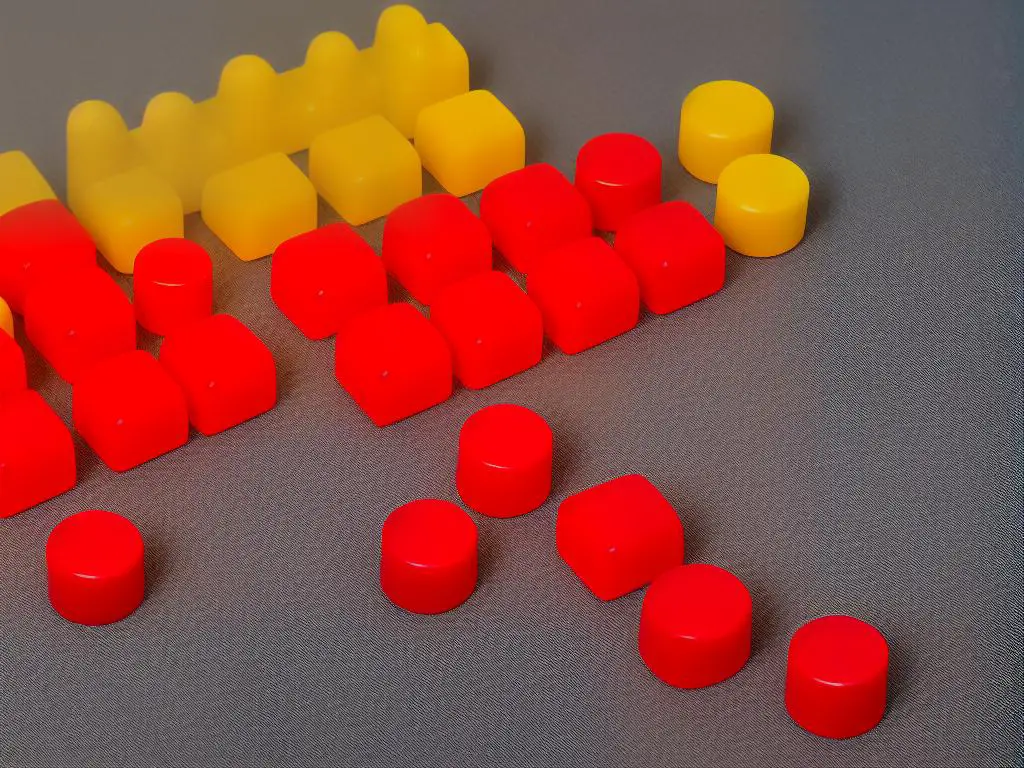Embarking on a quest to master the captivating game of Connect 4 and learning to play like a pro? This engaging game, which requires wits and tactics, has been entertaining players of all ages for decades. This article outlines crucial concepts, strategies, and ideas to help you enhance your skills and increase your odds of success. By understanding the rules, playing offensively and defensively, mastering different types of connections, anticipating opponent moves, and refining blocking techniques, you’ll be well on your way to becoming a Connect 4 champion!
Understanding the Rules and Basics
Grasp the main goal:
The objective of Connect 4 is to be the first player to form a horizontal, vertical, or diagonal line of four of your own tokens or game pieces, while preventing your opponent from doing the same. The game is typically played by two players, each using their own colored tokens (usually red and yellow).
Game board structure:
Familiarize yourself with the Connect 4 game board, which consists of a grid containing six rows and seven columns. The grid is designed to allow tokens to be dropped from the top through any column and settle in the lowest available row of that column, similar to the structure of a vertical shelf. Each player’s tokens will stack on top of each other in the columns they choose.
Player turns:
At the beginning of each game, the players decide who goes first. Turn-taking proceeds in an alternating fashion, with each player choosing an open column and dropping one of their tokens into it, occupying the lowest available space. It is important to carefully plan and strategize your moves in order to create a line of four tokens while also preventing your opponent from doing so.
Understanding winning moves:
Pay attention to the various ways that a player can win in Connect 4. One can win by connecting a horizontal line of four tokens within a single row, a vertical line of four tokens within a single column, or a diagonal line of four tokens that spans across rows and columns. Successful players anticipate opportunities to create these connections and recognize potential dangers by keeping an eye on their opponent’s moves.
Defensive play:
While focusing on completing your line of four tokens, don’t forget to block your opponent. Especially when they are close to achieving a winning line. A large part of winning Connect 4 comes from strategic defensive play and preventing your opponent from winning before you do.
Conclusion:
By familiarizing yourself with the Connect 4 game board, understanding the rules of the game, and implementing strategic thinking when dropping tokens, you are well on your way to increasing your chances of winning Connect 4. Good luck and have fun!

Playing Offensively and Defensively
Connect 4 is a classic board game that tests your strategic thinking, pattern recognition, and predicting ability. To win Connect 4, you must be the first player to connect four of your checkers in a row vertically, horizontally, or diagonally. Mastering offensive and defensive strategies is essential to ensure victory against your opponent.
Here are step-by-step instructions on how to play offensively and defensively in the game:
1. Set up the game:
To start, choose a color for your checkers (either red or yellow) and take turns with your opponent in dropping your checkers into the vertical grid. Each player chooses a column for their move and drops their checker into the slot, which fills it from the bottom up.
2. Playing offensively:
a. Start in the center: Begin your offensive strategy by controlling the center of the board. The middle columns provide the maximum number of directions to connect four checkers in a row, giving you more opportunities to win the game.
b. Build a base: Lay the foundation for your winning streak by placing your checkers in horizontal lines or stacking checkers vertically in columns to create consecutive checkers. Creating a strong base will give you more chances to extend your streak to four checkers.
c. Set up traps: Play offensively by setting up traps for your opponent. Create potential winning moves in two different directions (e.g., horizontal and diagonal) to force your opponents to choose between one of them, allowing you to complete the four-in-a-row on the next turn.
d. Look ahead: Plan your moves several steps ahead to maintain a strong offensive position. By anticipating your opponent’s moves, you can take control of the board and prevent them from blocking your winning streaks.
3. Playing defensively:
a. Block your opponent: Keep an eye out for opportunities to block your opponent’s winning streaks by placing a checker adjacent to their potential four-in-a-row. Prioritize blocking moves that would lead to an immediate win for your opponent.
b. Control space: Maximize your defensive strategy by controlling the space on the board. Focus on occupying crucial positions that would help your opponent complete their four-in-a-row or create potential winning scenarios in future turns.
c. Recognize threats: Develop a keen sense of pattern recognition to identify and counter any potential threats from your opponent. This skill helps you anticipate moves and block them before they become dangerous.
d. Cut off options: Be aggressive in your defensive play by limiting your opponent’s options. Focus on neutralizing their offensive tactics and forcing them into less advantageous positions, making it more challenging for them to create a four-in-a-row.
4. Balancing offense and defense:
To be both an expert offensive and defensive player, adapt your tactics based on your opponent’s moves. Pay attention to the board’s state and switch between offensive and defensive strategies when necessary. Knowing how to balance both the strategies is the key to securing your victory in Connect 4.
Practice these strategies and be prepared to adapt your gameplay to being more focused on offense, defense, or a combination of the two. The more you play and develop your skillset, the better your chances will be of winning Connect 4. Time to connect and conquer!

Mastering Vertical, Horizontal, and Diagonal Connections
Connect 4 is a classic two-player game where the goal is to get four of your colored discs in a row, either vertically, horizontally, or diagonally, before your opponent does. To increase your chances of winning, you must strategize and recognize specific patterns. Here’s a deep dive on how to align four disks of the same color vertically, horizontally, and diagonally.
1. Vertical Connections:
- Focus on columns to build your vertical connections. A vertical win involves stacking four of your disks on top of one another in the same column. Keep adding your pieces to an open column to build your connections, but make use of your opponent’s moves as well.
- Identify which columns your opponent is targeting and try to block their vertical connections by placing your disk on top of their stack.
- Choose columns that have more open spaces, as they allow you to build more connections.
2. Horizontal Connections:
- Set up potential horizontal connections by positioning your pieces across different rows. Try to have at least two or three of your disks in a row with open spaces on either side.
- Watch for your opponent’s moves and anticipate their next play. If they seem to be trying to block your horizontal connection, switch your focus to a different row or create a vertical or diagonal connection.
- Use diversion tactics, such as focusing on building a vertical connection, to distract your opponent from noticing your potential horizontal connection.
3. Diagonal Connections:
- Diagonal connections are the trickiest to master but can typically secure a win if executed correctly. Start by focusing on one of the diagonals and placing your disks in a way that creates a pattern that can lead to four in a row.
- Pay close attention to your opponent’s moves, as they may try to block your diagonal connection. If they block one side, switch your focus to the other diagonal direction.
- Set up multiple diagonal connections that intersect, making it harder for your opponent to block all of them.
General strategies to win Connect 4:
- Plan your moves ahead. Like in chess, try to be a few steps ahead of your opponent to anticipate their moves and build your connections accordingly.
- Control the center. The center columns offer more connection opportunities, as they have more chances to create horizontal and diagonal connections. Fight for control of the center and force your opponent to play in the outer columns.
- Always be on guard.Even if you are focusing on building your connections, don’t forget to keep an eye on your opponent’s moves. Block them when you see they are getting close to forming a connection.
- Use multiple strategies: Constantly switch between vertical, horizontal, and diagonal connections to keep your opponent on their toes and make it difficult for them to predict your moves.
Practice these tactics, and you’ll soon find yourself mastering the art of Connect 4. Remember, the key is to think ahead, adapt to your opponent’s moves, and maintain control of the game. Good luck!

Anticipating Opponent’s Moves
Understand the basic rules of the game: The main goal of Connect 4 is to connect four of your colored pieces in a row, either horizontally, vertically, or diagonally. Each player takes turns dropping their pieces into the slots of the game board.
Familiarize yourself with common tactics: To anticipate your opponent’s moves, you need to be familiar with the most common and effective game strategies. Some of the most successful tactics include building connections vertically, diagonally, and blocking your opponent’s attempts to create connections.
Focus on the center columns: The center columns offer more opportunities to create connections than the outer ones. Keep an eye on these columns to prevent your opponent from making a strong move and to identify potential winning moves for yourself.
Observe your opponent’s moves: Pay close attention to where your opponent places their pieces. This can give you insight into their strategy and help you counteract it. Ask yourself some questions: Are they trying to connect vertically, horizontally or diagonally? Are they trying to block you or create their own opportunity?
Plan two moves ahead: Develop a habit of thinking at least two moves ahead in the game. This will not only help you anticipate your opponent’s next move but also allow you to strategize accordingly.
Force your opponent into a defensive position: Try to make moves that force your opponent to block you, instead of focusing on their own connections. This will give you more control over the game and make it easier for you to predict their next move.
Be prepared to adapt your strategy: Sometimes, despite your best efforts at anticipation, your opponent may surprise you with a move you didn’t foresee. Stay flexible and be ready to change your strategy when needed.
Learn from your mistakes: Always analyze the outcome of your games to identify the moves that led to your victory or defeat. This can help you improve your ability to anticipate your opponent’s moves.
Practice, practice, practice: Like any skill, your ability to anticipate your opponent’s moves in Connect 4 will improve with practice. Play regularly, against different opponents, and push yourself to stay ahead in the game by predicting their moves.
Stay patient and focused: Anticipating your opponent’s moves may take some time and effort. Remain patient during gameplay and maintain your focus on the game board, the pieces, and your strategy.

Prioritizing the Center Column
Connect 4 is a popular two-player connection board game, where the objective is to be the first to form a horizontal, vertical, or diagonal line of four of one’s own discs.One key strategy to increase your chances of victory is prioritizing the center column.In a Connect 4 board featuring 7 columns, the center column (column 4) is the most crucial area to control because it gives you the highest likelihood of forming a winning combination.Opening moves are crucial for setting up a strong position in the center column.Pay close attention to your opponent’s moves and adjust your strategy accordingly.Sometimes, controlling the center column may not go exactly as planned.Once you have established a strong presence and controlled the center column, leverage this advantage by creating threats in multiple directions.Improving your ability to control the center column and win Connect 4 games takes practice.

Blocking Techniques
Introduction:
Connect 4 is a popular game that requires strategy, skill, and focus. The basic goal is to get four of your pieces to line up either horizontally, vertically, or diagonally before your opponent does. Simple! While making your own alignments is crucial, learning how to effectively block your opponent is just as important. In this guide, we will go through essential blocking techniques to prevent your opponent from forming four-in-a-row alignments and increase your chances of winning the game.
1. Be aware of your opponent’s moves:
- Always pay attention to the moves your opponent makes. This will help you to determine their strategy and anticipate where they may try to form a four-in-a-row alignment.
- Look for patterns and keep an eye on any sequences of two or three already connected pieces. These indicate a potential win for your opponent, and you’ll need to block them accordingly.
2. The vertical block:
- When you notice that your opponent has horizontally or diagonally connected two or three pieces consecutively, make your move directly above the opponent’s last placed piece to block a vertical alignment.
- Be careful not to accidentally create an opportunity for your opponent to win beneath your own blocking piece. Always assess how your move will impact the game before placing your piece.
3. The horizontal block:
- If your opponent is trying to align horizontally, place your piece next to their last one, either to the left or right. This will break the sequence and prevent them from forming a horizontal four-in-a-row alignment.
- Keep an eye out for double-ended sequences, where your opponent may potentially win from both sides. In these cases, it’s important to prioritize blocking the side that presents the most immediate threat.
4. The diagonal block:
- Diagonal alignments can be tricky to spot but are just as important to block. If your opponent has two or three diagonally connected pieces, place your piece on either end of their diagonal sequence to prevent them from winning.
- Be wary of forked threats, where your opponent may be trying to create two separate diagonal alignments at the same time. In these cases, assess which alignment is more dangerous and prioritize blocking it.
5. Defensive play:
- If you find yourself constantly on the defensive, try to balance your moves with both offensive and defensive plays. This prevents your opponent from having complete control over the board.
- Build up your own sequences while still keeping an eye on your opponent’s strategies, and be prepared to block them if needed.
6. Think ahead:
- Try to predict the moves your opponent might make in the future, and plan your defensive strategy accordingly. This will help you to be prepared when they make their move and quickly block them if necessary.
- Planning your moves ahead of time is crucial not only for creating your own four-in-a-row alignments but also for effectively blocking your opponent’s plans.
Conclusion:
Mastering the blocking techniques in Connect 4 will give you a significant advantage in the game. Always be aware of your opponent’s moves, recognize patterns, and prioritize blocking the most immediate threats. By incorporating these essential strategies into your gameplay, you’ll be well on your way to winning more Connect 4 games against your competitors. Good luck!

Practicing Your Connect 4 Skills
Familiarize yourself with the game rules. Before you can become a Connect 4 expert, you must thoroughly understand the game rules. The objective of the game is to connect four of your own discs in a horizontal, vertical, or diagonal row before your opponent does. The game is typically played on a 6×7 grid, and each player takes turns dropping their discs into the available slots.
Play regularly: To improve your skills, play Connect 4 as often as possible. Practicing regularly will help you become more adept at recognizing winning moves and anticipating your opponents’ strategies. You can play with family and friends or even online against computer bots or other players through various websites and apps.
Focus on the center columns: The center columns give you the most opportunities to create winning combinations, as they provide more directions for your four-disc streak. Prioritize placing your discs in the center of the board to increase your chances of winning and limit your opponent’s options.
Develop multiple strategies: As you play more Connect 4, you’ll likely discover various tactics and techniques that work well for you. Developing multiple strategies will make you a more versatile player and better equipped to handle different game scenarios. Experiment with both offensive and defensive techniques to keep your opponent guessing.
Block your opponents: Pay close attention to your opponent’s plays and actively block them from completing their streak of four. This is a crucial aspect of Connect 4, as your success depends not only on your ability to create winning combinations but also on your ability to hinder your opponent’s progress.
Plan ahead: Take time to consider each move you make. It’s essential to think at least two or three moves ahead to predict the possible outcomes of your plays. This foresight will help you identify opportunities for winning or blocking your opponent.
Learn from your mistakes: Analyze the games you lose to understand what went wrong and what could have been done differently. Reflecting on your errors will give you valuable insights into which tactics and strategies work best in specific situations and help you improve your future decision-making.
Watch and learn from others: Observe skilled Connect 4 players by watching videos, looking over gameplay reviews, or participating in online forums. This will give you a greater understanding of various strategies and help you find creative solutions to in-game situations you may not have considered.Stay adaptable: As you begin to develop your tactics and strategies, remember that every game of Connect 4 is different. Be prepared to change your tactics as the game progresses, and always consider how your opponent may try to counter your moves.
Have fun: Like any game, the key to success in Connect 4 is to enjoy yourself. Relax, have fun, and continually strive to improve your skills. With time and consistent practice, you’ll become a formidable Connect 4 opponent.

Analyzing Past Games of Connect 4
Start by gathering records or memories of your past Connect 4 games. If you didn’t take notes or photos during your games, try to recall them as vividly as you can.
Look for patterns in the game, such as what moves were commonly made and consider how they affected the outcome of the game. For instance, if you consistently started by placing pieces in the center column, did it increase your chances of victory?
Review your winning games and identify the strategies or tactics you used. Take note of how you blocked your opponents or how you created a winning sequence of four. Pay attention to the moves and thought processes leading to those victories.
Similarly, analyze the games you lost. Determine what went wrong, such as failing to recognize a potential winning move or not anticipating an opponent’s strategy. Look for areas where you can improve and prevent the same mistakes in future games.
Reflect on your opponents’ tactics as well, especially those who consistently beat you. Analyze their moves and try to understand what made their strategies effective. Adopting or countering these tactics in your future games can potentially increase your chances of winning.
As you reflect on past games, consider adopting tactics you have not used previously. For instance, try focusing on a more defensive approach if you have been primarily offensive, or attempt different sequences of moves to catch opponents off guard. Don’t be afraid to be creative and try new approaches.
After analyzing your games, make a list of your strengths and weaknesses. This will help you prioritize areas for improvement and fine-tune your Connect 4 skills.
Based on your reflections, set actionable goals to improve your gameplay. Focus on addressing your weaknesses while also strengthening your existing skills. For example, you can set a goal to block an opponent’s winning sequence more effectively or to create more opportunities for a winning move.
To see growth in your Connect 4 abilities, practice playing more games, ideally against a variety of opponents. Frequent practice allows you to implement your new strategies, adjust your approach, and learn from diverse experiences.
Continuously analyze your recent games to assess your progress and refine your strategies. Recognize which tactics are working well for you and identify any lingering weaknesses. Always be open to change and further development, as this will ultimately help you become a more skilled Connect 4 player.

As you continue to invest time in practicing, analyzing past games, and refining your strategies, you will find yourself becoming a formidable Connect 4 player. The key to success lies in adopting a balanced approach and prioritizing key areas of play. Now, armed with your newfound knowledge of techniques and tactics, go forth and dominate the grid!
FAQ – Mastering the Art of Winning Connect 4 Every Time
Q: Is it really possible to win Connect 4 every time?
A: While winning every single game of Connect 4 may not be feasible, mastering strategies and tactics can significantly increase your chances of winning consistently. This page provides valuable insights and techniques to improve your gameplay.
Q: What are some basic tips for winning Connect 4?
A: Basic tips for winning Connect 4 include starting in the center column, focusing on building both vertical and diagonal connections, and setting up traps to force your opponent into making disadvantageous moves. This page delves deeper into advanced strategies to maximize your winning potential.
Q: How can I improve my Connect 4 skills?
A: Improving your Connect 4 skills requires practice and a deep understanding of the game. Study the strategies discussed on this page, play against skilled opponents, analyze your games to identify mistakes, and continue learning from experienced players. With time and effort, you can enhance your skills and become a formidable Connect 4 player.
Q: Are there specific strategies to counter an opponent’s moves?
A: Yes, this page explores various counter-strategies to neutralize your opponent’s moves. By anticipating their potential winning moves and applying defensive tactics, you can disrupt their plans and turn the game in your favor. Learning these strategies will help you respond effectively to your opponent’s moves.
Q: Are there any advanced tactics discussed on this page?
A: Yes, this page delves into advanced tactics to give you an edge in Connect 4. It covers concepts like creating multiple threats simultaneously, recognizing patterns, and understanding strategic trade-offs. By mastering these advanced tactics, you can elevate your gameplay and outmaneuver your opponents.
Q: Can I use these strategies in competitive play?
A: Absolutely! The strategies and techniques discussed on this page can be applied in both casual and competitive settings. However, keep in mind that experienced players may also adapt their tactics, so it’s important to continuously improve and stay versatile.
Q: Are there any alternative rules or variations discussed?
A: This page primarily focuses on the standard rules of Connect 4. However, variations and alternative rules may be mentioned or briefly touched upon. It’s always recommended to clarify the specific rules being used with your opponent before playing.
Q: Can children or beginners benefit from this page?
A: Yes, this page provides valuable information for players of all skill levels. It covers both basic and advanced strategies, making it beneficial for beginners seeking to improve their gameplay as well as experienced players looking to refine their techniques.
Q: Where can I find more resources to enhance my Connect 4 skills?
A: In addition to this page, there are many resources available online, such as tutorials, videos, and forums, where you can further expand your knowledge of Connect 4 strategies. Engaging with the Connect 4 community can also provide valuable insights and opportunities to learn from other players.